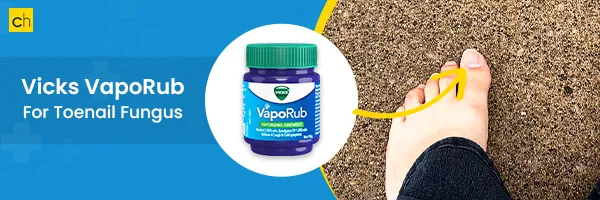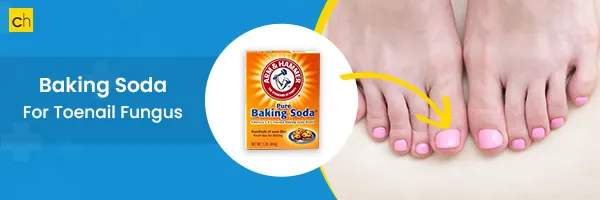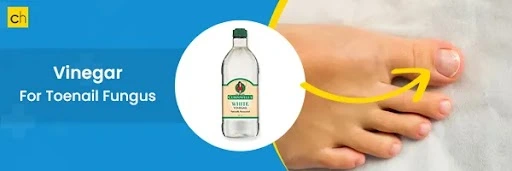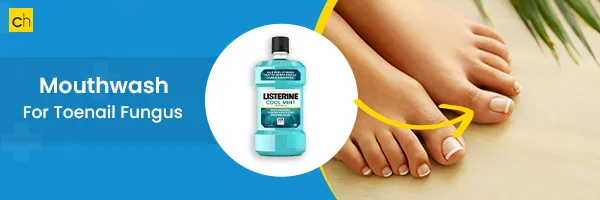Are you experiencing toenail fungus? Searching for an instant solution to toenail fungus? Don’t worry! You are not alone. It is a common condition causing discomfort for many. Toenail fungus is known as onychomycosis in medical terms which is basically caused by fungal infection. It starts with a small spot and turns to crumbling your nails. But have you ever wondered why this happens and what kills toenail fungus instantly?
Reasons can vary but we have a lot of treatment options to get rid of toenail fungus instantly. Read on this blog, we'll explore garlic, snakeroot extract, oregano oil, ozonized sunflower oil, baking soda, and vinegar. Additionally, learn about Hydrogen Peroxide for toenail fungus and bleach for effective treatment. We will also discuss the potential reason behind such a type of fungus. Continue to explore!
But first know that there is no quick solution for toenail fungus. You need consistent treatment for several months to see the effective results.
What Kills Toenail Fungus Instantly?
If you want an instant solution to get rid of toenail fungus, you can try these simple and natural remedies. However, when these remedies are ineffective, medical treatments are the only options.
1. Vicks VapoRub

Vicks VapoRub is a topical ointment that we use when we have a stuffy nose or a cough. It has some special ingredients like menthol and eucalyptus oil. These ingredients can help fight toenail fungus and make our nails look better. A published study has confirmed that Vicks VapoRub for toenail fungus is a safe and effective treatment.
How to use: Apply Vicks VapoRub to your toenail and cover it properly with sterile gauze.
2. Apple cider vinegar

You can use Apple cider vinegar for early-stage or mild toenail fungus. It will create an acidic environment around the nail fungus, making it difficult for the fungal spores to grow. Soak your feet in apple cider vinegar to treat your toenail fungus. Treating toenail fungus with apple cider vinegar will take almost five months.
How to use: You can simply soak your foot in diluted apple cider vinegar.
3. Garlic

Garlic has antifungal and antioxidant properties. Research has found that garlic can fight against microorganisms known as M. guilliermondii and R. mucilaginosa, which are responsible for causing toenail fungus.
How to use: Apply crushed garlic juice to the affected toenail and leave it on for an hour. Repeat daily for potential relief from toenail fungus.
4. Snakeroot extract

Snakeroot is a plant mostly you can find in every park and home. This is one of the most beneficial remedies to prevent toenail fungus. According to one clinical trial snakeroot extract helps to relieve the symptoms of toenail fungus.
How to use: Take a few drops of Snakeroot extract. Apply directly to the affected nail. Wash it off after an hour.
5. Oregano oil

-
Oregano oil consists of essential oils and vitamin E that can help reduce the infection of toenail fungus.
-
The thymol in it has antibacterial and antifungal properties that help reduce toenail fungus.
How to use: Add a few drops of oregano oil and coconut oil. Mix properly on the affected nails. Leave it and dry it for some time.
6. Ozonized sunflower oil

-
The ozonized sunflower oil has helped lessen the symptoms of toenail fungus as it can inactivate the activities of fungi, bacteria, and yeast.
-
It basically treats the activity of these microorganisms through ozone gas.
How to use: Apply a drop of sunflower oil on the affected area. Cover it with a normal gauze piece. Wash it after an hour.
7. Baking soda or sodium bicarbonate

-
Baking soda helps reduce fungal infections by absorbing moisture, which is a breeding ground for fungi.
-
However, the mechanism of action of sodium bicarbonate has yet to be explored. Still, it is an effective home remedy for toenail fungus infections.
How to use: Take half a tablespoon of sodium bicarbonate or baking soda. Mix it well with water and form a thick paste. Apply it to the affected area. Keep it up for 20 to 30 minutes, then wipe it off.
8. Vinegar

Vinegar has versatile benefits for treating toenail fungus. You can use vinegar as it acts as an antimicrobial and antifungal. It helps to recover your toes from fungal infection. There are no studies to prove it. However, vinegar is one of the most historic remedies used in many home remedies.
How to use: Mix vinegar in the water and add it to the tub. Soak your affected feet in the tub for 20 minutes in the solution. Repeat it at least two to three times a day.
9. Tea tree oil

-
Tea tree oil is one of the most beneficial oils to reduce the growth of Trichophytonrubrum, a fungus that can significantly cause toenail fungus.
-
Its antibacterial and antiseptic properties alleviate the risk of secondary bacterial infections that can develop near damaged nails.
How to use: Dilute the tea tree oil with some other carrier oil, such as coconut oil. Soak your feet in that solution for a few minutes.
10. Listerine Mouthwash

-
If you are running out of time, you can try Listerine mouthwash.
-
It is found that Listerine mouthwash has antifungal properties and fungus-fighting abilities, which are good for the treatment of toenail fungus.
How to use: You can mix Listerine mouthwash in warm water or white vinegar. Then, soak your feet for an hour at a time.
11. Over-the-Counter (OTC) Medications

Itraconazole, Ciclopirox, Tavaborole, and Efinaconazole are effective over-the-counter toenail fungus treatments that help kill the yeast or fungus and put a halt to their growth. This is how you can use these antifungal medications:
-
Itraconazole: Take it for at least 3 months once a day or as suggested by your doctor.
-
Ciclopirox: Apply it directly to the affected area once a day (at night). Let it dry and cover it with socks or stockings. Don’t wash the affected area with water for up to 8 hours.
-
Tavaborole: Apply it directly to the infected toenail and cover it with socks or cotton.
-
Efinaconazole: Apply it directly to the infected toenail and avoid touching the solution directly to the cuticles or surrounding skin. After applying, wait for at least 10-20 minutes before washing.
Note: When these remedies are ineffective or symptoms worsen, medical treatments are the only options.
How is Hydrogen Peroxide for Toenail Fungus?
Hydrogen peroxide is known as a great bleaching agent for toenail fungus. It has antifungal and antiseptic properties, which will help get rid of toenail fungus. It kills fungus and breaks down the collected debris present on the surface of the nails. You soak your foot in the hydrogen peroxide and water solution. But here are some precautions to take when using hydrogen peroxide:
-
Do not apply hydrogen peroxide that is beyond 3 percent concentration as it can cause burns, irritation, and other allergic reactions on the skin.
-
Moreover, always try to dilute the hydrogen peroxide with water to decrease the harsh effect of hydrogen peroxide.
|
Note: You should always use proper techniques and methods to use hydrogen peroxide for nail fungus effectively and in the correct proportion. A study suggests effectively treating toenail fungus with hydrogen peroxide to achieve the best and safest possible results. |
How Long Does It Take for Hydrogen Peroxide to Kill Toenail Fungus?
Dermatologists believe that regular use of Hydrogen Peroxide for toenail fungus can heal your nails within a week. However, the recovery usually depends on the severity of the infection. It is recommended to continue the use of hydrogen peroxide for toenail fungus for a couple of months at least to properly heal and prevent further infections. Moreover, it is also important to note that hydrogen peroxide for toenail fungus is just a tried and tested method. It doesn’t have any scientific studies behind it. But, still, it is considered a safe and effective method for treating toenail fungus.
Does Bleach Kill Toenail Fungus?
Yes, bleach can kill toenail fungus. All you have to do is mix it with water and soak your feet in it. While bleach has some antifungal properties, it is not designed for use on the nails and can be harsh on the skin and nails. It may lead to skin irritation or damage without effectively treating the underlying fungal infection. Usually, people are concerned about how long it takes for bleach to kill toenail fungus. Well, it will typically take almost five or six months.
Medical Treatments for Toenail Fungus
When the home remedies are not providing efficient relief, you can move forward with some medical treatments for toenail fungus mentioned below:
1. Oral Antifungal Medications
-
Doctors may prescribe oral antifungal medications such as fluconazole, itraconazole, and terbinafine to treat the fungus.
-
They will ask you to take the medicine each day for many months or even longer.
2. Topical Medications
-
The healthcare providers may recommend topical medications like Ciclopirox ( a medicated nail polish and Efinaconazole & Tavaborole (medicated nail creams) that are applied to the injured toenail.
-
These medications take a longer time to treat the infection.
3. Laser Treatment
-
Some people prefer laser treatment over medications as pills have side effects.
-
Laser treatment involves directing the high-energy laser beam or light to the affected toenail and treating it.
-
It typically takes 2 sessions five to six weeks apart. The first session will show results in about 2 months.
4. Surgery
In the case of persistent or severe toenail fungus, the providers may suggest the following surgery:
-
Partial Nail Avulsion: Removal of the infected area of a toenail.
-
Total Nail Avulsion: Removal of the whole affected toenail.
Do you know what causes toenail fungus? We will discuss all the potential reasons so that you can lower the chances of its recurrence.
Side Effects of Toenail Fungus Treatment
Both topical and oral toenail fungus treatments can lead to some side effects.
Oral Antifungals: Oral medications like Terbinafine can cause these side effects:
-
Itchy rash
-
Headaches
-
Stomach ache
-
Diarrhea
-
Nausea
In severe cases, it can impact the liver, so healthcare providers often conduct blood tests to ensure safety.
Topical Medications: Ciclopirox, amorolfine, or efinaconazole can lead to side effects like:
-
Redness
-
Swelling
-
Stinging, or burning sensation at the application site.
Note: If you experience any symptoms, see a doctor.
What are the Possible Reasons for Toenail Fungus?
So, here are some reasons that may lead to the development of toenail fungus.
-
Contagious infection: You may have developed a skin-to-skin infection by coming in contact with someone who has a skin infection like ringworm, athlete's foot, etc.
-
Excess water exposure: Such infections develop when you walk barefoot in water for a long time, and your fingers get soaked in the water. It produces whitish, light, and sensitive skin prone to bacterial attack.
-
Shared toiletries: You can also get toenail infections by sharing fingernail clippers with other infected persons.
-
Fungal infection: If you have worn smelly, sweaty, and old socks for a long time at your workplace, fungal infections affect the nails when you get a small cut surrounding your nail or there's a crack in your nail.
-
Bacterial infection: Any separation allows bacteria, fungi, and other microorganisms to enter the skin. Once developed in any finger, the infection can spread to other fingers or toes.
How to Prevent Toenail Fungus?
After the use of home remedies and medical treatments, you can still get toenail fungus. Here are some effective ways you can consider to prevent getting it in the future:
-
Keep both feet completely clean and dry.
-
Wear shower shoes when using public bathrooms, locker rooms, or on wet deck pools.
-
Keep changing your socks and shoes daily. Better to wear breathable shoes and socks.
-
Wear shower shoes or flip-flops to avoid catching it from an infected family member.
-
Make sure to clean your nail clipper every time you use it.
-
Always trim your nails short.
-
Soak your feet in a bucket of warm water before trimming them.
-
Soak your nails in warm water before cutting them, or cut right after your shower.
-
If your toenail fungus reoccurs, consult with the doctor.
When to Consult a Doctor for Toenail Fungus?
You should consider visiting a doctor for toenail fungus if,
-
Home remedies or over-the-counter treatments have yet to improve the condition.
-
The toenail fungus is causing significant pain, discomfort, or spreading to other nails or areas.
-
You have an underlying medical condition like diabetes that can increase the risk of complications.
-
You notice signs of a bacterial infection alongside the toenail fungus, such as increasing redness, swelling, or pus.
-
Even if you have concerns or questions about the best treatment approach for your case.
Final Thoughts
We have explored a lot of home remedies and medical treatments on what kills toenail fungus instantly. We’ve also learned about Hydrogen Peroxide for toenail fungus and how to use it effectively. Keep in mind that patience is crucial, as these remedies may take time to get optimal results. If home remedies are not working, medical treatments like antifungal creams, prescription medications, and laser therapies are good options. Consult an experienced dermatologist if the symptoms persist.
Frequently Asked Questions
How long does it take baking soda to kill toenail fungus?
It takes around 7 days for the baking soda to treat toenail fungus.
What household item kills toenail fungus?
White vinegar has been shown the best product to kill fungus in your toenail.
Can you put vinegar directly on the toenail fungus?
Yes, putting vinegar directly on your toenail can treat fungus. Its antimicrobial and acidity properties form an unfavorable environment for fungal growth.
What is the strongest over-the-counter medicine for toenail fungus?
Lamisil AT Antifungal Cream is the effective OTC medication for toenail fungus.
What kills toenail fungus instantly?
Hydrogen peroxide kills the toenail fungus instantly, but you should use it with caution.
What happens if you have toenail fungus for too long?
It can permanently damage your toenail. Additionally, if it spreads to other areas, it can cause other severe infections.
How to know if toenail fungus is dying?
To tell if your toenail fungus is dying, watch for these symptoms: reduced discoloration & thickness, foul odor, thick and brittle nails, a growth of clear and healthy nails from the base, decreased pain or discomfort, and a decrease in tenderness around the nail.
Can I wear nail polish if I have toenail fungus?
No, it is not recommended. It's because there is a risk of trapping the moisture which creates a breeding place for the fungus, worsening the fungal infection.

Reviewed by





